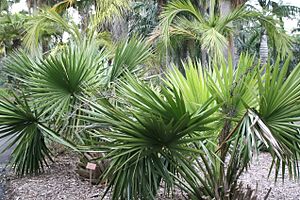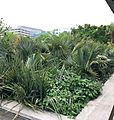Dwarf palmetto facts for kids
Quick facts for kids Dwarf palmetto |
|
|---|---|
 |
|
| Scientific classification | |
| Genus: |
Sabal
|
| Species: |
minor
|
| Synonyms | |
|
Synonymy
Corypha minor Jacq.
Sabal adansonii Guerns. Chamaerops glabra Mill. Corypha pumila Walter Rhapis arundinacea Aiton Chamaerops acaulis Michx. Sabal caroliniana Poir. Rhapis acaulis (Michx.) Walter ex Willd. Chamaerops arundinacea (Aiton) Sm. Chamaerops louisiana Darby Sabal adiantina Raf. Sabal pumila (Walter) Elliott Sabal minima Nutt. Chamaerops sabaloides Baldwin ex Darl. Brahea minima (Nutt.) H.Wendl. Sabal glabra (Mill.) Sarg. Sabal deeringiana Small Sabal floribunda Katzenstein Sabal speciosa L.H.Bailey Sabal louisiana (Darby) Bomhard |
|
Sabal minor, commonly known as the dwarf palmetto, is a small species of palm. It is native to the deep southeastern and south-central United States and northeastern Mexico. It is naturally found in a diversity of habitats, including maritime forests, swamps, floodplains, and occasionally on drier sites. It is often found growing in calcareous marl soil. Sabal minor is one of the most frost and cold tolerant among North American palms.
Distribution
This palm's native range spans on the Atlantic Coast from central Florida north to Monkey Island, North Carolina. On the Gulf Coast, it spans from central Florida to central Texas, Arkansas, north to southern Oklahoma and northern Alabama, then south in the State of Nuevo León in Mexico.
Description
Sabal Minor grows up to 3 meters in height, with a trunk up to 30 centimetres (12 in) diameter. It is a fan palm (Arecaceae tribe Corypheae), with the leaves with a bare petiole terminating in a rounded fan of numerous leaflets. Each leaf is 1.5–2 metres (4 ft 11 in – 6 ft 7 in) long, with 40 leaflets up to 80 centimetres (31 in) long, conjoined over half of this length. The flowers are yellowish-white, 5 millimetres (0.20 in) across, produced in large compound panicles up to 2 metres (6 ft 7 in) long, extending out beyond the leaves. The fruit is a black drupe 1 to 1.3 centimetres (0.39 to 0.51 in) long containing a single seed.
Cultivation
Sabal minor is one of the most cold hardy palms in cultivation. It does best however, when grown in hot and humid tropical summer conditions, and may struggle or grow slowly in cool summer climates. It is leaf hardy to near 0 °F (−18 °C), and has been known to survive brief periods of −5 °F (−21 °C) temperatures. It is generally cultivated in subtropical and warm temperate climates. S. minor can grow in a wide variety of soil types, and is often found submerged in swamps in the subtropical southeastern United States. It grows in both full sun and shaded locations, though it will do best in the cooler garden zones (below zone USDA 7) in full sun and a wind sheltered location.
In the United States, since the 1960s, cultivation of Sabal minor has spread beyond the deep southern United States. S. minor is cultivated along the East Coast from Florida to coastal Connecticut, and on the West Coast from Vancouver BC south to San Diego. It is a recommended horticultural plant by the Virginia Cooperative Extension. There are several cultivars, including those from the Outer Banks of North Carolina (northernmost strains), and those from Oklahoma and Texas. One popular strain is 'McCurtain', named after McCurtain County, Oklahoma, where they are native. These tend to remain trunkless and smaller than those from warmer areas. S. minor is a popular landscape palm in coastal resort areas from Virginia Beach, Virginia, to southern Texas.
Gallery
Images for kids
-
Dwarf palmettos (Sabal minor) at Palmetto State Park, Texas USA (2 June 2007)
-
Sabal minor and resurrection fern (Pleopeltis polypodioides) growing on oak limb, Big Thicket National Preserve, Hardin Co. Texas, USA (23 October 2019)
-
A dwarf palmetto frond Congaree National Park, South C, USA (8 November 2008)
-
Sabal minor and Needle Palm, also from the southeast, are the world's most freeze hardy palm species.
See also
 In Spanish: Sabal minor para niños
In Spanish: Sabal minor para niños











